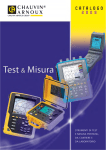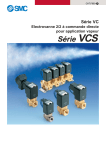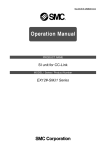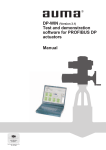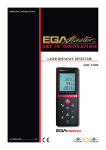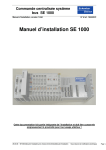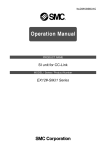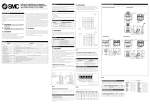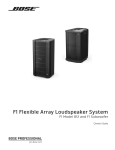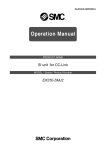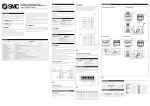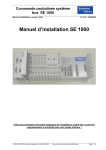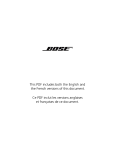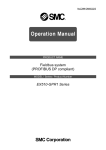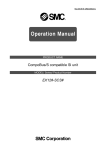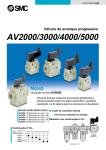Download EX12_-SPR1-B
Transcript
EO312-B Instruction Manual PROFIBUS-DP SI units EX120-SPR1-B EX121-SPR1-B EX122-SPR1-B Index Page 1. 1.1 1.2 System overview System description SI unit EX12#-SPR1-B 2 2 3 2. 2.1 2.2 2.3 System configuration Systematic configuration PLC types and PCs Connectable SMC solenoid valves 4 4 6 6 3. 3.1 3.2 3.3 3.4 Technical data System technical data PROFIBUS-DP technical data SI unit technical data Electromagnetic compatibility (EMC) 7 7 7 8 9 4. 4.1 4.2 4.3 Description of SI unit EX12#-SPR1-B Description of individual components Diagnostics display (status LEDs) Diagnosis of Slave 10 10 11 12 5. 5.1 5.2 Settings Address settings Transmission speed (baud rate) 13 13 14 6. 6.1 6.2 6.3 6.4 Installation Bus connection Bus cable Bus termination Valve wiring 15 15 16 17 17 7. 7.1 18 18 7.2 7.2.1 7.2.2 7.3 Programming Data link layer (layer 2) and PROFIBUS-DP service access points used Connection with PROFIBUS-DP Master GSD File Configuration of a PROFIBUS-DP Master System reaction time 19 19 20 21 8. Troubleshooting 22 9. SMC contact addresses 24 1 1. System overview 1.1 System description The PROFIBUS-DP is an open, manufacturer-independent field bus. This makes it possible to use any PROFIBUS-compatible PLC or PC plug-in card as a Master for the PROFIBUS. PROFIBUS-DP is a deterministic, decentrally controlled field bus that uses the socalled “Delegated Token”, generally operated with one Master and is suitable for cyclical PLC/IPC control. The EX12#-SPR1-B SI units described here support the manufacturer-independent PROFIBUS-DP protocol concerning IEC 61158 resp. EN 50170. The PROFIBUS-DP protocol (decentral periphery) 32 active or passive participants can be connected, or 122 when using a maximum of three signal amplifiers (repeaters). Different transmission speeds are possible dependent on the max. bus length. The baud rate is automatically detected by the SI unit and can be between 9.6 kBit/sec and 12 Mbit/sec. The transmission media used are shielded, paired two wire cables in compliance with the above PROFIBUS-DP standard (RS 485). 2 1.2 SI unit EX12#-SPR1-B The SI unit makes it possible to control the SMC solenoid valves via the PROFIBUSDP protocol. All three housing types EX120, EX121 and EX122 contain identical electronics. Only the mounting types are different. Housing type: EX120 EX121 EX122 Type of connection: Direct mounting without ribbon cable, no DIN rail mounting DIN rail mounting with ribbon cable Direct mounting without RC for DIN rails for SMC valve type: VQ, SV SY SY Each Serial-Interface (SI) unit can control a maximum of 16 single solenoid or 8 double solenoid valves. Combinations of single and double solenoid valves are possible as long as the number of coils does not exceed 16. These SI units do not have sensor inputs. The SI solenoid valve manifold is already wired internally. This means that the manifold only needs to be connected to the bus line (9 pole D-Sub) and the power supply (5 pole round connector). The address of the bus participant can either be set via the two rotary switches on the front of the device (hardware addressing - proposed) or via the bus protocol (software addressing). Hardware addressing (default) is recommended in advantage to see the adjusted slave address directly. An internal selector switch determines which of the two address settings is permitted. It must also be ensured that the correct GSD file which corresponds to used address setting mode is used. 3 2. System configuration 2.1 Systematic configuration There are two types of Master for the PROFIBUS-DP: Master class 1: Communication with Slaves and with control signal networks, e.g. PLC Master class 2: For setup and checkout purposes, e.g. Programming Device (PD) Example a) Operation without repeater * Rt: Termination resistor combination * for 1.5 MBit/sec, stubs must not be used! 4 Example b) Configuration with a repeater The valve configurations shown here are interchangeable under the SI units. A maximum of 16 output drivers are available per SI unit. The termination resistors must be connected to the start and end of the PROFIBUSDP cable. This can be implemented by using external resistors or special bus connectors that have an integrated switchable termination resistor. At higher baud rates (> 1.5 MBit/sec), connectors with integrated line inductance must be used due to the capacitive load of the participant and the resultant line reflection (see technical guidelines for PROFIBUS-DP Interconnection Technology). 5 According to the PROFIBUS-DP standard, a maximum of three repeaters are permitted, i.e. one repeater after every 31 Slaves. The number of repeaters affects the maximum number of bus participants: e.g. a maximum of 30 bus participants can be connected with one repeater and a maximum of 28 participants can be connected with three repeaters per line. 2.2 PLC types and PCs The SI solenoid valve manifold (SI unit + valve manifold) can be controlled by any PLC, with an appropriate interface component as the bus master, or by a PC plug-in card. The interface component or the PC plug-in card must be designed as a PROFIBUS-DP standard Master. There are a large variety of such devices or PC plug-in cards available from various manufacturers. 2.3 Connectable SMC solenoid valves Solenoid valves in the series VQ1000/2000 can be connected with EX120-SPR1-B and solenoid valves in the series SY3000/5000 can be connected with EX122/EX121-SPR1-B. These valve series, in addition to the “SI solenoid valve manifold” design, are also available with 25 pole D-Sub connectors as electrical input. Order designation of the multi-connection sub-bases for solenoid valve manifolds EX120 Type: EX121 Type: EX122 Type: VV5Q#1-####SN-#-Q SS5V#-1#S3ND-###-## SS5Y#-45S1ND-###-##-Q SS5Y#-45SND-###-##-Q Note: The letter N indicates the field bus system PROFIBUS-DP in the multi-connection sub-base. Important: In the VQ series valves, the valves with the “Negative Common” resp. “Minus Common” configuration must be used (i.e. 24 VDC is switched to the valve and the ground is common), e.g. VQ1101N-5-Q. Further technical data regarding the valves and valve sub-bases can be found in the corresponding SMC product catalogues (address directory in appendix). 6 3. Technical data 3.1 System technical data Operating temperature Storage temperature Relative humidity CE marking Degree of protection 0°C... +50°C -20°C... +85°C 10-95% without condensation Yes IP 20 (DIN 40050/IEC 144) 3.2 PROFIBUS-DP technical data (as per EN 50170) Operating mode of SI solenoid valves Max. number of participants without repeater: Maximum number of repeaters Number of bus participants (with three repeaters) Transmission speed (baud rate) and max. cable length without repeater (automatic baud rate detection) Hamming distance Cable type Cable parameters Impedance [Ω] Capacitance [pF/m] Loop resistance [Ω/km] Core diameter [mm] Core cross-section [mm²] Transmission media (cable) The SI unit is designed as a passive participant (Slave) for the PROFIBUS-DP 32 participants (Master, Slave) 3 126 participants (Slaves). Operation as monomaster system is recommended. Dependent on bus length and cable type A or B used Baud rate: [kBaud] 12000 6000 3000 1500 500 187.5 93.75 19.2 9.6 Cable type A [m] 100 100 100 200 400 1000 1200 1200 1200 Cable type B [m] Not permitted Not permitted Not permitted Not permitted 200 600 1200 1200 1200 4 Cable A as per PROFIBUS-DP standard EN 50170 Cable B as per PROFIBUS-DP standard EN 19245, Part 1 Cable A Cable B 135 to 165 100 to 130 (3.. 20MHz) (>100kHz) <30 <60 <110 <160 >0.64 >0.53 >0.34 >0.22 Shielded, paired two wire cable, impedance 100 to 130Ω Min. 0.22mm² (24 OVG), approx. 60pF/m 7 Bus structure Connection type: Supply voltage: Bus connector: Galvanic isolation Line, closed at both ends with terminating resistors, adapted to RS 485. Stubs to participant as short as possible, no branching. 5 pole round connector as per DIN 45322 9 pole D-Sub connector 50 Veff rated voltage 500Veff rated surge voltage 3.3 SI unit technical data Supply voltage Current consumption electronics Current consumption load (valves) Outputs: - Number - Output performance per output - Voltage - Polarity of outputs - Fuse protection of outputs Min. Slave Interval Diagnostics functions: - Bus fault display - Diagnosis display e.g. valve voltage too low - Supply status display +24V DC electronics +24V DC rated voltage ± 10% Allowable range 21.6V DC to 26.4 V DC Separate power supply for electronics and load (valves) Common reference potential Max. 70 mA at rated voltage without load Max. 1.4 A 16 max. 2.1W +24V DC ± 10% Minus Common 1 micro-fuse per Byte, 2Byte 0.1 ms LED red “BF” LED red “DIA” LED green “RUN” 8 3.4 Electromagnetic compatibility (EMC) Interference transmission EN50081-2, 1993 EN55011 Class A Gr. 1 Resistance to interference Enclosure EN50082-2, 1995 EN61000-4-2 ESD 4kV Contact/8kV air ENV50140 HF-Field 10V/m 80... 1000 MHz ENV50204 HF-Field 10V/m 900 MHz B A A Bus connection EN61000-4-4 Burst 2kV ENV50141 HF-conducted 10V, 0.15... 80 MHz EN61000-4-4 Burst 2kV ENV50141 HF-conducted 10V, 0.15... 80 MHz A A A A Mains (DC) Benchmark category A: Benchmark category B: Normal operating behavior within specified limits Temporary influence of operating behavior or loss of function that the device self-corrects. 9 4. Description of SI unit EX12#-SPR1-B 4.1 Description of individual components 18-pole ribbon cable connector 5-pole round connector RUN LED DIA LED -B BF LED 2 rotary switches for the station number 9-pole D-Sub socket Sliding switch for Address Mode The externally visible individual components are described below. 5 pole round connector The supply voltage for the electronics (SI unit) and for the valves (load) can both be connected simultaneously through the connection of a 5 pole mating socket. The PS round connector complies with the DIN 45322 standard. Top view 3 4 2 5 1 PIN 1: PIN 2: PIN 3: PIN 4: PIN 5: +24V DC valve voltage 0V electronics PE, functional protective earth +24V DC electronics 0V valve voltage Note: The +24V DC valve voltage and the + 24V DC supply voltage for the electronics are electrically isolated from each other. PIN 3 (PE) must be connected with the shield connection in the mating section of the round plug connector. 10 9 pole D-Sub socket: The 9 pole D-Sub socket connects the SI unit with the field bus PROFIBUS-DP. The connections of the 9 pole D-Sub socket are assigned as follows: PIN 1 PIN 2 Shield M24 PIN 3 PIN 4 PIN 5 PIN 6 PIN 7 RxD/TxD-P RTS DGND VP P24 PIN 8 PIN 9 RxD/TxD-N CNTR-N Shield/protective earth not occupied (reserved for 24V DC supply ground line) Receive/transmission data-P; B line Ready to Send Digital Ground +5V for external bus connection not occupied (reserved for 24V DC auxiliary power) Receive/transmission data-N; A line not occupied (reserved for repeater control signal, direction control) The signals shown in bold (Pin 3, 5, 6 and 8) are essential signals for data exchange (mandatory signals). 4.2 Diagnostics display (status LEDs) The status LEDs RUN (green), DIA (red) and BF (red) on the front plate indicate the status of a SI unit. LED Meaning RUN (green) Status (after configuration) lit up DIA (red) not lit up lit up Not OK A fault has occurred in the valve control system (e.g. the supply voltage for the solenoid valve has dropped below permitted value) BF (red) not lit up lit up No fault Bus fault! During the set monitoring period, no communication cycle occurred on the bus not lit up No fault Supply voltage +24V DC for SI unit OK 11 4.3 Diagnosis of Slave EX12#-SPR1-B The parameters specified correspond to the diagnosis telegram according to EN 50 170. The DP Slave diagnosis in hexadecimal format has the following meaning: Diagnosis telegram Message/Meaning 0000: 00 0C 00 02 14 01 07 00 00 00 00 00 00 Response monitoring activated i.e. All OK 0000: 01 00 00 02 14 01 00 00 00 00 00 00 00 DP Slave cannot be reached via bus (e.g. electronics voltage too low) 0000: 08 0C 00 02 14 01 07 FF 00 00 00 00 00 Response monitoring activated Slave-specific diagnosis data (e.g. valve voltage too low) It is assumed here that the DP Master has address 2 and that the SI unit is addressed with the rotary switches, i.e. the GSD file 1401 is used. 12 5. Settings 5.1 Address settings The address of the SI unit can be assigned either using both rotary switches (hardware addressing) or via the bus protocol (using a class 2 Master). In general, address 1 is kept for the Master. A small sliding switch inside the SI unit determines the type of addressing used. The sliding switch is located on the valve connection board to the left of the 18 pole ribbon cable connector. The appropriate GSD file must be used according to the position of the sliding switch. Selection sliding switch on: + Default setting o GSD file The address is assigned using the rotary switch on the front plate (HW addressing) Valid address range: 02 to 99 (decimal) SMCB1401.GSD The address is assigned via the bus protocol. (SW addressing) SMCB1400.GSD Valid address range: 02 to 126 (decimal) The rotary switches are no longer operational Attention: Each address may only be assigned once per bus participant. The address of the SI unit is set by default to 03 (left switch decimal digit, right switch single digit) and the sliding switch is set to +. The SMCB1401.GSD file must be used in this case. This type of addressing should be used because the station address on the device is then visible. Any modification to the address using the rotary switch is only detected after the electronics are switched back on again and saved in an EEPROM. To set the rotary switch, remove the transparent plastic cover first. A modification to the address using the bus protocol, i.e. using a class 2 Master, is immediately effective and saved in the internal EEPROM. It is not necessary to start up again. (File: SMCB1400.GSD, sliding switch on o) 13 18-pole valve connector Selection sliding switch + o Valve connection board with sliding switch for addressing mode. 5.2 Transmission speed (baud rate) The SI unit automatically detects the baud rate specified by the PROFIBUS-DP Master. The unit supports all transmission speeds specified in the PROFIBUS-DP standard up to 12 MBit/sec. The maximum permissible length extension of the PROFIBUS-DP network is inversely proportional to the baud rate (see technical data). 14 6. Installation All installation and wiring work must be carried out with the system supply voltage switched off. When installing PROFIBUS-DP participants, comply with the VDE provisions for cable-saving transmission systems (VDE 0113, Part 1 and EN60204, Part 1) and with the PROFIBUS guideline “Interconnection Technology for PROFIBUS”. In addition, the entire configuration must be implemented according to the “Configuration Guidelines PROFIBUS-DP/FMS”. The valve manifold is equipped with two connectors. - power supply - bus connection (5 pole round connector) (9 pole D-Sub plug socket) Both connectors must be connected before commissioning. The SI unit must also be connected to the valve block. 6.1 Bus connection The connection of the bus participants can be implemented as described in Chapter 2.1, “Schematic configuration”. Please comply with the manufacturer instructions for the PLC or PC card used and with EN 50170/DIN 19245. 1. All connections must be implemented with the supply voltage switched off. 2. The SI unit and the bus cable must be located at least 200 mm away from any interference sources (e.g. power inverter) and power lines. 3. Use cable type A as recommended in the Chapter “Technical data”. 4. The bus must be terminated with terminating resistors after the last bus participant (normally a defined, switchable resistor at the bus connector). 15 Example: Minimum wiring with double-sided shielding between two bus participants Participant 1 9 pole D-Sub RxD/TxD-P, PIN 3 DGND, PIN5 RxD/TxD-N, PIN 8 Participant 2 9 pole D-Sub Cable B Cable A Shield PIN 1 RxD/TxD-P, PIN 3 DGND, PIN5 RxD/TxD-N, PIN 8 Shield PIN 1 The two signal cables A and B must not be mixed up 6.2 Bus cable The bus cable must be a shielded, paired two wire (twisted pair) cable as per EN 50170. Note: The cable shield in the D-Sub plug must be connected over a large surface with the metal collar. A single-sided earthed shield prevents interfering low frequency earth loops, but has no effect against magnetic HF interference. Pairing is effective against magnetic HF interference, but has no influence on electric HF actions. A double-sided earthed shield is effective against magnetic HF interference, but has no effect against electric HF interference. For this reason, specific recommendations cannot be provided. The applicable industrial ambient influences must be taken in account in each case. A commercial bus cable of cable type A as per EN 50170 is recommended in general. 16 6.3 Bus termination Both ends of the bus cable must be fitted with a termination resistor combination to avoid interfering line reflections and to ensure a defined quiescent potential. The lines are defined as closed when the termination resistance (Rt) is equal to the impedance of the line. The termination of the PROFIBUS-DP network must be implemented according to the PROFIBUS guideline “Interconnection Technology for PROFIBUS”, Chapter 3.1, or EN 50170. 6.4 Valve wiring The solenoid valve manifold is already internally wired. It must therefore only be connected to the previously mentioned supply voltage (5 pole round connector) and the bus connection (9 pole D-Sub). The SI unit has 16 output drivers, therefore a maximum of 16 solenoid valve coils can be actuated. The output drivers are allocated to the solenoids as described below. The 18 pole ribbon cable connector connects the SI unit with the valve block (18 pole ribbon cable for EX121 housing). The pin assignment is shown in the following diagram. + Pin No.: 1 3 5 7 9 11 13 15 17 Bit: 1 0 3 2 5 4 7 6 9 8 11 10 13 12 15 0V 14 0V Pin No.: 2 4 6 8 10 12 14 16 o 18 The diagram shows a top view of the 18 pole ribbon cable connector, the sliding switch is located to the left. The output drivers are numbered 0 through 15, corresponding to the bits in a word-wise allocation in the control system. Pins 17 and 18 are provided for the common ground of the solenoid valve coils. VQ series solenoid valves A solenoid valve manifold up to 8 stations is double-solenoid wired by default. If a double-solenoid valve is located on the first station of the valve manifold, i.e. a valve with two coils, then Coil A is controlled with Bit 0 and Coil B with Bit 1. On the valve itself, when Coil A is actuated, a red LED lights up, and when Coil B is actuated, then a green LED lights up. If station 2 has a single-solenoid valve (5/2-way valve only with Coil A), then this is actuated by Bit 2, and Bit 3/Pin 3 is not used. Any wiring diverging from this must be specified using Option K (special wiring) in the order specifications. In a solenoid valve manifold with 16 single-solenoid valves, the coils from station 1 to 16 are assigned Bits 0 to 15. The maximum number of 16 coils must not be exceeded. 17 SY series solenoid valves Double-solenoid valves in the SY series occupy two stations because of the design, i.e. each station is individually wired. The valve stations of the manifold from 1 to 16 are allocated to Bits 0 to 15 (Station 1 = Bit 0, Station 2 = Bit 1, etc.). 7. Programming 7.1 Data link layer (layer 2) and PROFIBUS-DP used Service access points The so-called ISO/OSI reference model represents open field buses, such as PROFIBUS-DP. This model is defined in 7 layers, from layer 1 (physical layer) to layer 7 (application layer). Layer 2 (data link) is positioned on layer 1. Layers 3 to 6 are generally not used in field bus systems, therefore layer 7 is positioned directly over layer 2. Up to 244 bytes of net data can be transmitted per telegram (+ 11 bytes for the header). Communication After a RESET or after voltage is restored, the Master attempts to contact all assigned Slaves in a communication sequence set from the smallest to the largest address. The following telegram sequence is maintained during booting: 1. 2. 3. 4. 5. Diagnosis request (Optional station address change, Class 2 Master only) Slave parameterization Slave configuration Diagnosis request before data exchange to ensure that booting phase concluded correctly 6. Data Exchange 7. (Global Control) Further, more detailed descriptions can be found in the corresponding standards. 18 7.2 Connection with PROFIBUS-DP Master 7.2.1 GSD file A GSD file (Electronic Data Sheet [German: “Geräte-Stamm-Datei”]) is necessary for configuring each PROFIBUS-DP participant. This file contains the specific slave data of the SI unit. The GSD file contains data such as, e.g. the number and type of I/O channels or the specification of diagnosis texts. The GSD file is certified within the framework of a PROFIBUS-DP product and must not be modified by the user (read only). The data of the GSD file refer to the bus protocol chip used in the SI unit with the designation LSPM2 (Lean Siemens Profibus Multiplexer). When the LSPM2 has received a fault-free telegram, it automatically generates the required response telegram according to EN 50170. The chip is capable of automatically detecting the baud rate set. During this search (after each RESET and each expiry of the watchdog timer) inputs and outputs are not manipulated. The LSPM2 starts the search at the highest baud rate 12 MBit/sec and works sequentially through each baud rate until it detects a fault-free telegram. 19 7.2.2 Configuring a PROFIBUS-DP Master The GSD file must first be included in the programming environment of the respective automating system. This is implemented during hardware configuration in the Siemens SIMATIC Manager. The new GSD file can be installed using the menu item Extras. Additional Field Devices It is also possible to copy the GSD file to a suitable directory in the configuration tool. It may then be necessary to update the hardware catalogue (here: C:\SIEMENS\STEP7\S7DATA\GSD). The GSD file is now integrated in the configuration tool and a PROFIBUS-DP system can now be created and the SMC valve manifold added. This is implemented by double clicking the corresponding variant (HW or SW) in the catalogue. The SIMATIC Manager automatically provides the addresses of the input and output bytes. The Slave number selected in the hardware configuration must correspond with the number set for the SI unit and must not be assigned twice. 20 The modules highlighted in blue in the upper half are displayed in the table below. The control system assigns the output bytes 0 and 1 in the EX120 (AB 0 and AB1). The solenoid valve manifold in this example has the Slave or Station number 3 and is actuated by the output bytes 0 and 1. In a fully assigned valve manifold, Coil A of the first station is addressed with the address A 0.0 and the last solenoid valve coil has the address A 1.7 (16 Bit: A0.0, A0.1...A0.7 and A1.0, A1.1...A1.7). 7.3 System reaction time The system reaction time of a PROFIBUS-DP system depends on the following factors: • • • • • Number of bus participants TSDR (the reaction time in which a participant can respond) the selected baud rate the agreed net data length Min_Slave_Interval (the time between two poll cycles in which a Slave can exchange data with the Master; in the LSPM2 used here, this period is 0.1 ms) A more detailed calculation of the transmission speed can be found in standard EN 50 170 or in the appropriate specialist literature. 21 8. Troubleshooting The following process flow is used in the case where a solenoid in a SI solenoid valve manifold is not working correctly. This process flow uses the three status LEDs of the SI unit. If the fault cannot be found using this method, refer to the more comprehensive diagnostic information provided by the Master (see the user manual and software description of the PLC or PC used). General Recommendations: - Connect new SI and check it one after the other. - Assure +24VDC ± 10% at each SI (i.e. at the end of power supply lines) after connecting all SI-s. - Assure different addresses of all connected SI-s. 22 Solenoid valve not functioning Replace SI unit No Is the green RUN LED lit up? No Is the +24VDC±10% available for the electronics? No Are both fuses OK? Yes Yes Connect +24VDC Contact SMC Yes Yes Is the wiring OK? Yes Does the red BF LED light up after booting? Yes Slave address OK? Yes Is the Master OK? No No Is the red DIA LED lit up? No Set all addresses correctly Set control system to RUN Yes Is +24VDC±10% available for the valves? No Check +24VDC for valves Yes No No Is the wiring OK? Resolve wiring problem Ja Replace SI unit No Restart Master and check status Is the solenoid valve working? Contact SMC 23 9. SMC contact addresses Germany SMC Pneumatik GmbH Boschring 13-15 63329 Egelsbach, Germany Tel: (0049) 06103/402-0 PO box 12 10 63324 Egelsbach, Germany Fax: (0049) 06103/402-139 Austria Greece Spain SMC Pneumatik GmbH Girakstrasse 8, A-2100 Korneuburg Phone: 02262-62280 Fax: 02262-62285 S. Parianopoulus S.A. 9, Konstantinoupoleos Street GR-11855 Athens Phone: 01-3426076 Fax: 01-3455578 SMC Espana, S.A: Zuzobidea 14, Pol. Ind. Jundiz E-01195 Vitoria Phone: 945-184 100 Fax: 945-184124 Belgium Portugal Switzerland SMC Pneumatics N.V./S.A. Nijverheidstraat 20 B-2160 Wommelgern SMC Espana SMC Pneumatik AG Dorfstrasse 7, Postfach 117 CH-8484 Weisslingen (Sucursal Portugal), S.A. Phone: 03-355-1464 Fax: 03-355-1466 Rua de Eng° Ferreira Dias 452, 4100 Porto Phone: 02-610-89-22 Fax: 02-610-89-36 Denmark Italy UK SMC Pneumatik A/S Knudsminde 4 B DK-8300 Odder Phone: +4570252900 Fax: +4570252901 SMC Italia S.p.A Via Garibaldi 62 I-20061 Carugate, (Milano) Phone: 02-92711 Fax: 02-92150394 SMC Pneumatics (UK) Ltd Vincent Avenue, Cronhill, Milton Keynes, MK8 0AN Phone: 01908-563888 Fax: 01908-561185 Finland Netherlands SMC Pneumatikka OY Veneentekijantie 7 SF-00210 Helsinki Phone: 09-681021 Fax: 09-6810233 SMC Pneumatics BV De Ruyterkade 120 NL-1011 AB Amsterdam Phone: 020-5318888 Fax: 020-5318880 France Ireland SMC Pneumatics Ltd. SMC Pneumatique, S. A. 1, Boulevard de Strasbourg, Parc Gustave Eiffel Bussy Saint Georges F-77607 Marne La Vallee Cedex 3 Phone: 01-6476 1000 Fax: 01-6476 1010 Phone: 052-396-3131 Fax: 052-396-3191 2002 Citywest Business Campus Nass Road, Saggart, Co. Dublin Phone: Fax: 01-403 9000 01-464 0500 24

























